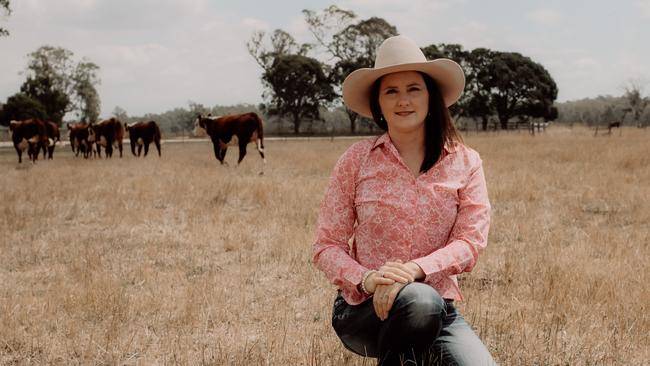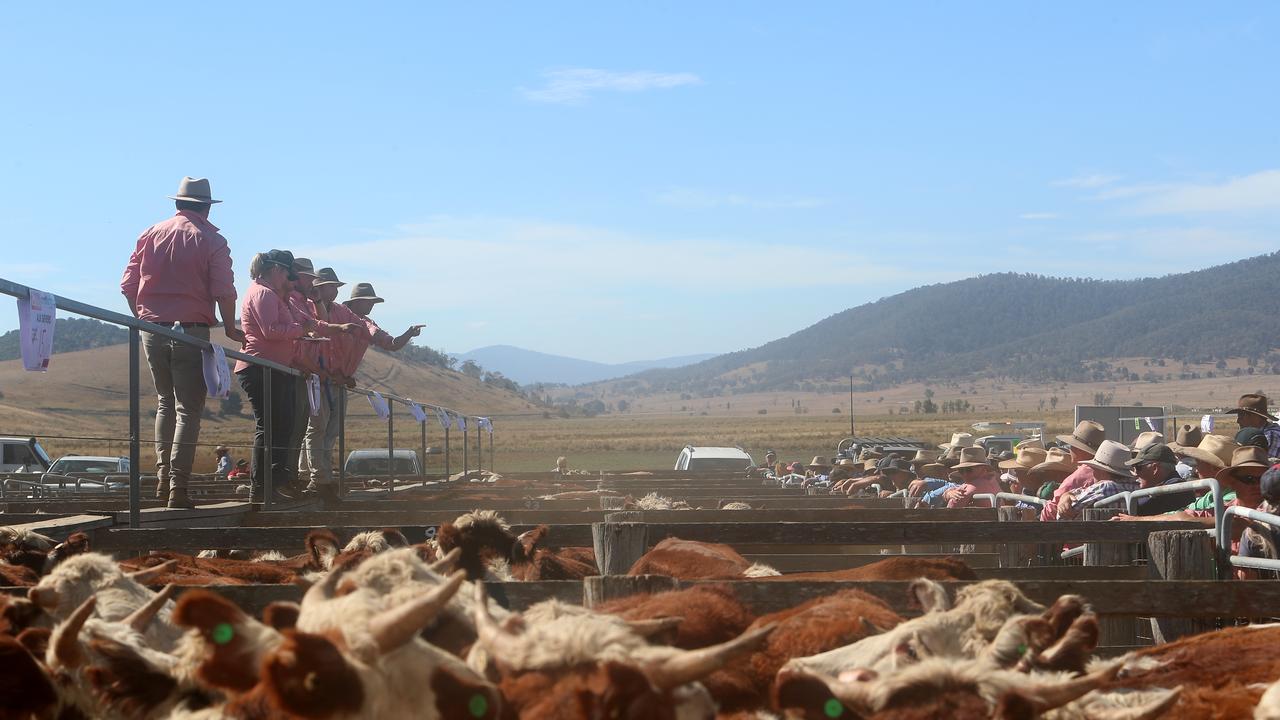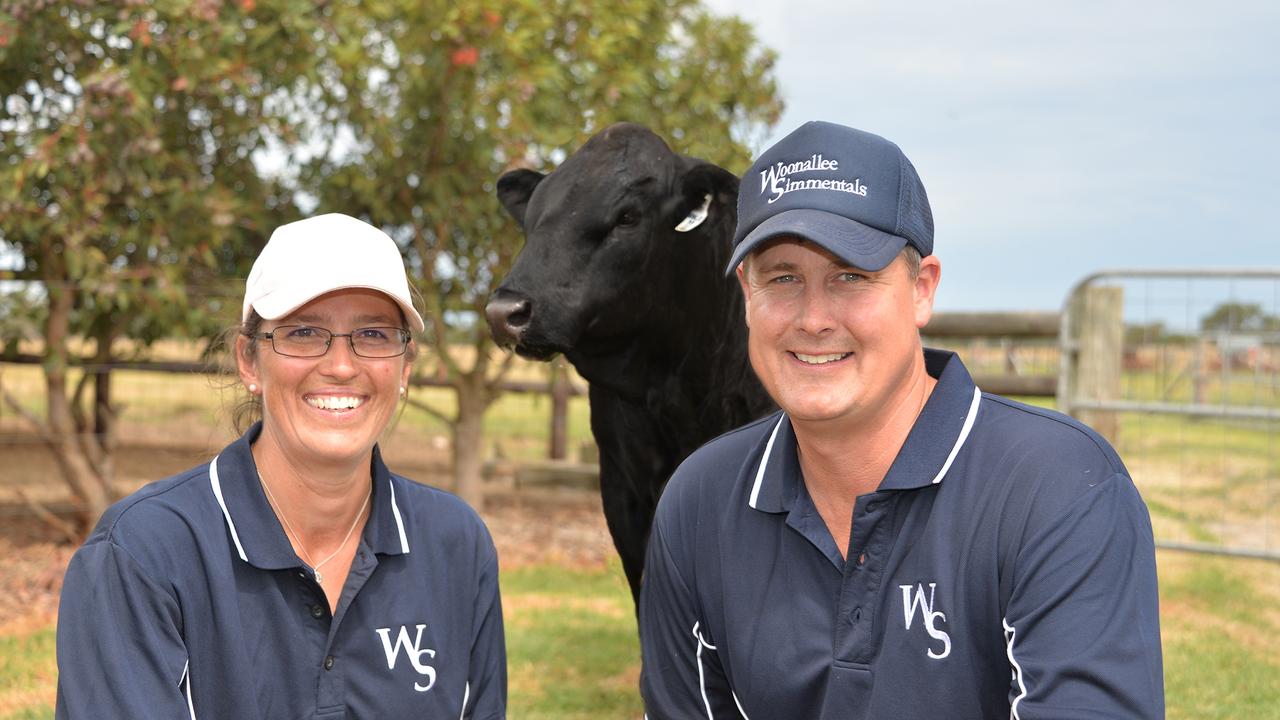Mawarra Genetics: How combining two breeds make business sense for the Sykes family
Use of Breedplan is behind the success of a high-profile Gippsland cattle stud, writes Madeleine Stuchbery.

Integrity is key to everything this husband and wife duo do, fuelled by a passion for propelling both the Hereford and Angus breeds forward into the future.
Deanne and Peter Sykes are the team behind Mawarra Genetics, based at Longford, in Gippsland.
The pair run the stud, originally known as Mawarra Herefords, which was established in 1963 by Peter’s parents.
Once known for their Hereford cattle, the Sykes have incorporated an Angus herd into their business, and have rebranded as Mawarra Genetics.
It’s a move Deanne says is key to satisfying all their clients’ needs.
“We identified an opportunity in Gippsland, and we’ve always been interested in providing the cattle that our clients are looking for,” Deanne said.
“About 20 years ago we introduced polled Herefords to the traditional horned Herefords we had. The Angus is another step in that direction.
“It’s been a really exciting development for us. It’s the same philosophy for breeding as what we have for the Herefords. It’s based on really strong female foundations, then using proven sires so we can build that breeding herd base.”
Angus cattle were sourced from studs in 2018, including Yancowinna, Witherwood, and Anvil Angus.
“This year is the first year we’ve been selling Angus bulls under the Mawarra Genetics prefix,” Deanne said.
At first glance, it may seem an interesting choice to not move solely to Angus, but to incorporate Angus into an existing stud program, but for the Sykes, it makes sense.
“It’s the same philosophy for breeding (Angus) as we have for the Herefords,” Deanne said. “It’s based on really strong female foundations, then using sires — proven sires. At this stage so we can build that breeding herd base.”
CLIENTS RULE
Integrity is at the core of everything Peter and Deanne do.
“We pride ourselves on being able to understand the markets our clients are targeting,” Deanne said. “We provide genetics for their programs, and then further down the supply chain.
“It’s important for us to understand what their markets are, and where they’re selling their calves.
“We’re just one point along the chain.”
The Mawarra Genetics enterprise spans two properties in Gippsland: about 470ha at the Mawarra home property near Longford, and a recently acquired property near Traralgon, spanning 475ha.
It was an opportunity for expansion, Deanne said, along with drought-proofing the farm.
“There’s more reliable rainfall (at Traralgon) even though it’s about 30 minutes away,” Deanne said.
“Our river flat country here (Longford) is similar, but there’s probably heavier carrying capacity at Traralgon.
“It’s also a bit of a blank canvas, and we’re really excited about that.”
Both properties are bordered by the Latrobe River, which in recent days has flooded following torrential rain.
The Sykes are working to clean up the 480ha of country currently under flood waters.
Thankfully, all cattle are safe.
Across the two properties the Sykes run about 450 breeding cows.
“Then we bring through approximately 120 bulls for sale each year,” Deanne said.
“On top of that we’ve got replacement heifers, and about 50 recipient dams.”
The Sykes’ Traralgon property houses the breeding cows.
Mawarra Genetics run about one cow and cow calf for every 1.2ha.
“This is not something we measure,” Deanne said.
“We carry animals to a range of ages prior to sale, as is required for a stud operation.”
The Sykes use artificial insemination as well as embryo transfers.
Bulls are joined to about 40 cows, with the aim to calve heifers at 2½ years old, “which suits our seasons”.

Cows are managed in large mobs, by calving cycle, except for when they are joined.
Heifers are run in large mobs according to age, until they’re joined.
And bulls are run in mobs according to age until they are split into smaller sale mobs three months before sale.
For the Sykes, structure in an animal is the most important thing.
“We utilise Breedplan as a selection tool to improve the commercially relevant traits of weight-for-age, high EMA, IMF, and positive fats, while maintaining our strong emphasis on maternal genetics,” Deanne said.
“EBVs are an important selection tool and we strive to provide animals that have industry leading numbers without sacrificing the structure and phenotype that our clients have come to expect.”
At birth, cattle are weighed and tagged with their dam’s ID.
Throughout their lives, cattle have their 200-day, 400- day, and 600-day weights recorded, as well as being scanned for fats, EMA and IMF, mature cow weights, all calving ease, days to calving, scrotal details and for the Hereford cattle, herd pigment and horn status.
Calves are yard weaned at five to eight months of age, depending on the season.
The Sykes retain about 80 per cent of female calves for future breeding.
“But we do sell stud females of all ages,” Deanne said.
“Our annual sale includes joined and unjoined heifers, and we have a feature female sale (all ages represented) every three years”.
POPULAR PROGENY
With a laser-like focus on genetics and breeding, the Sykes are able to provide their clients with the best cattle they can produce.
And it’s a program which has paid off, big time.
The strength of their breeding program was on full display at the recent Hereford National Show and Sale where Mawarra exhibited seven bulls, including that top-priced bull.
The top price bull, Mawarra If Only Q264, fetched an impressive $103,000.
This stellar result came off the back of years of the drought that gripped East Gippsland until 2020.
”This has been one of the best springs and summers we’ve come through in decades,” Deanne said.
“There’s a long way to go, and trying to catch up after four years of very severe drought for us is a challenge, but it’s a more positive situation.”
As the drought recovery — and now flood recovery — continues, Peter and Deanne will continue to focus on what matters the most: their clients.
“We’re about making sure our clients choose the best genetics,” Deanne said.
“We believe with the amount of bulls we sell, we’re confident there’s a bull here which will improve the bottom line of any beef producer.
“We feel strongly about that.”
MORE
MAJOR FEEDLOT LEADS RACE AT YEA STORE CATTLE SALE
AUSTRALIA-UK FREE-TRADE DEAL: PRIME MINISTERS REACH IN-PRINCIPLE AGREEMENT
RABOBANK SURVEY: FARMER CONFIDENCE IN VICTORIA LOWER THAN TASMANIA, NSW



